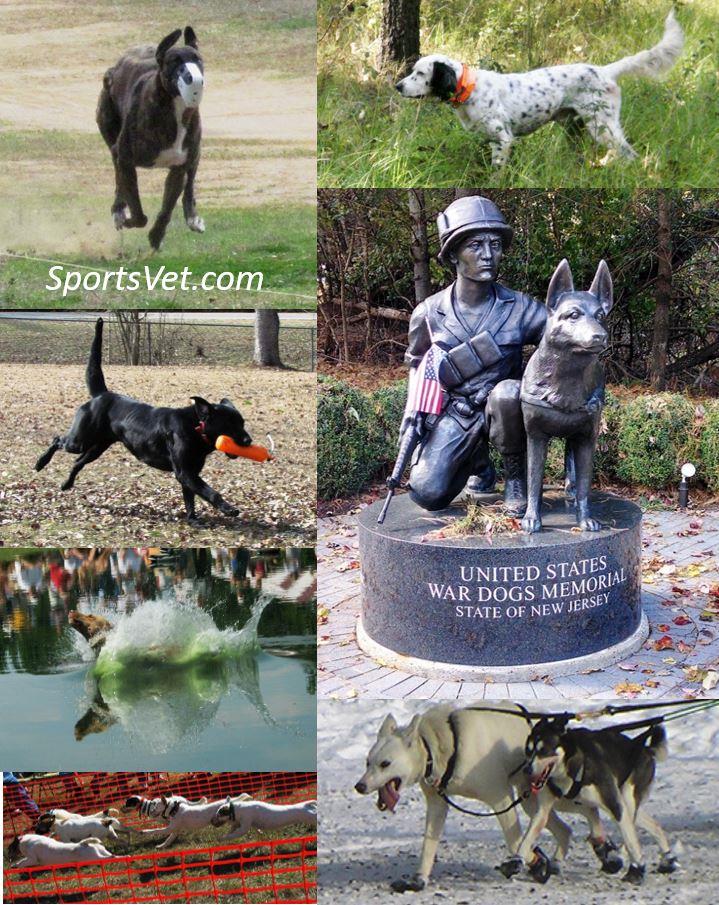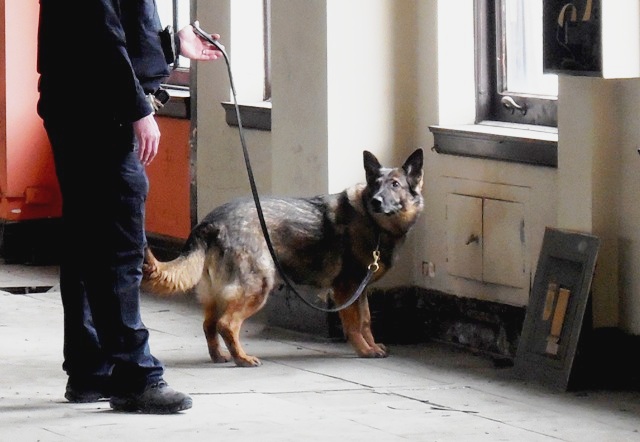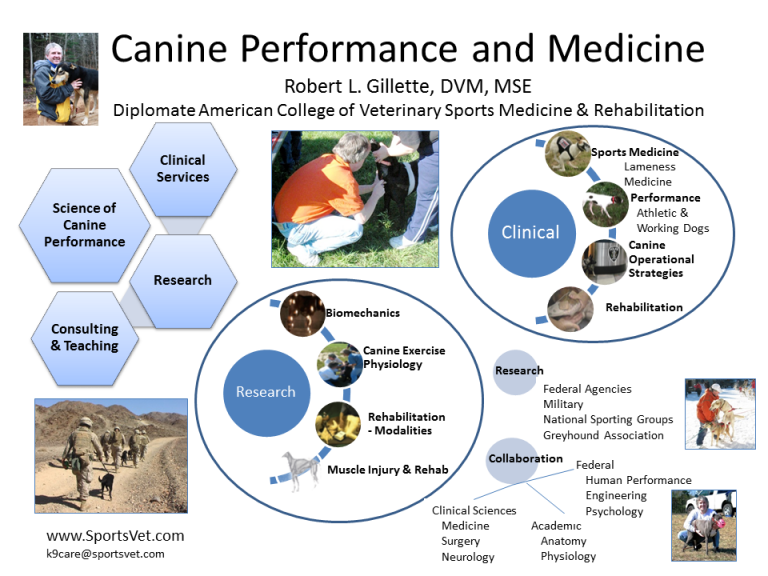Performance Science and Sports Medicine in the Athletic and Working Dogs
Performance science is a relatively new field in Veterinary Medicine. Performance Science aims to maximize canine performance in terms of endurance, physical fitness, metabolic efficiency and the ability to resist, postpone or prevent disease or injury. It also aims to enhance the dog’s sensorial and behavioral activities. This area of Sports Medicine has access to a greater number of clientele and dogs then the Sports Medicine area which typically deals with injuries and sports or activity related sickness.
- Performance Science (Pre-Performance efforts)
- This area of medicine includes conditioning and training for optimum output and prevention of illness and injury.
- Genetics, Training, Conditioning, Nutrition, Injury Prevention
- Sports Medicine (Post-Event Management)
- Injury or medical management includes the decisions of treatment or therapy of an injury or medical event and the related rehabilitation efforts that allows the athlete or working dog to return to its work safely and efficiently.
- Nutrition, Medical Care, Injury Treatment, Rehabilitation, Reconditioning
Dogs participate in many activities. It is very important for the Veterinarian to have an understanding of the activities related to the performance of their athletic or working dog patient. It is also important for them to understand at what level these tasks will be requested. For example, the abilities of the Military Working Canine are very important to those individuals whose lives may be dependent upon their efforts. The management and veterinary care selections for these cases should be designed to allow for optimal performance, minimized downtime and, from a rehabilitation standpoint, a return to full performance capabilities. Other dogs who participate in professional activities also require a high level of Veterinary expertise, a Performance Scientist or experienced Dog Handler who understand their work, sport and participation environment to allow them to perform optimally. Breeding decisions many times are made through analysis of canine performance. How the athletic or working dog is utilized may play a role in husbandry and management design related to performance and decisions related to treatment options and follow up care. Canine breeding and breeding selection for performance is not typically included in the general studies of most veterinary colleges. Therefore the Veterinarian or Performance scientist who works with Athletic or Working dogs requires a unique skill set and knowledge base to help the owners and handlers who manage or own these dogs.

Athletic and Working Dogs
The list of dog related activities is quite diverse and includes many activities. It is important to note that these dogs are participating in activities that they enjoy doing, have been bred to perform and have been trained to handle the related tasks. There are almost as many activities as there are breeds of dogs. Therefore it is helpful to have an understanding of the all of the activities. The following is a list of performance definitions and sports in which dogs participate. It does not include all sports and working efforts of the dogs but is meant to be a general guide to some of the more common events and give an example of the diversity of dogs activities.
Professional vs Nonprofessional
Professional efforts are divided into two areas. One is where the dog (animal) is performing their activity to achieve financial gain or competing for a purse. This typically includes greyhound racing, sled dog racing, horse racing, camel racing, pigeon racing, etc. The other area is where the dogs (animals) are competing or working in a non-monetary scenario but they are managed by paid professionals. This can include competitive efforts or working efforts. The competitive events can include but are not limited to professional competitions like all-age pointing dog stakes, field trial retrieving, flushing, herding, IPO (Internationale Prüfungs-Ordnung – used to be called Schutzhund), etc. Professional working efforts can include, but are not limited to, detection dogs of the federal agencies, law enforcement and fire department; dual-purpose dogs of the military and law enforcement; and contract dogs performing similar duties. It also includes the large operational kennels of the private and for-profit plantations and hunting operations.
Nonprofessional efforts can be competitive or operational. This group can range from a workout companion to various levels of competition or work. In the competitive events, there will not be a purse or financial reward. Most often the handlers or owners are not getting compensated to manage or work the dog. Many non-competitive working events are in scenarios where the dog is used to assist the handler/owner. Examples of these activities may include, but are not limited to: working livestock (ie cattle, sheep, etc), hunting (game or bird), service/guide efforts, etc. They may also include detection efforts like Search and Rescue, Avalanche dogs, etc or non-detection events like Water rescue Newfoundlands, where the handlers may be part of a recognized organization and get reimbursed for expenses but are not on a payroll.
Professional Dog Competitions and Activities
Greyhound Racing
- breed involved: Greyhound
- sprint exercise
- follow a false prey around an oval track
- hunt by vision, not scent
Sled Dog Racing
- breeds involved include the Selective-Bred dogs, Alaskan Sled Dogs, Siberian Husky, Samoyed, and Alaskan Malamute
- endurance exercise / strength exercise
- team of dog pull a sled and musher cross-country over natural terrain
- sprint & long distance racing, 4-100 miles up to 1150 miles
Professional Working Dogs
Detection: Bomb, Explosive, Tracking, Misc.
- breeds most commonly used are Belgian Malinois, German Shepherds, Labrador Retrievers, Springer Spaniel or similar breeds
- dogs are used to detect narcotics, weapons, explosives, mold, and termites
- dog is trained to sit when they recognize a target odor and point the handler in the direction of the scent
- Governmental Agency
- DHS Agencies
- Secret Service
- Customs and Border Patrol
- TSA
- Capital Police
- Military
- Law Enforcement
- Contractual Private Industry

Patrol Dogs (Aggression work)
- breeds most commonly used are Belgian Malinois, German Shepherds, or similar breeds
- Law Enforcement
- Military
- Contractual Guard Dogs
Dual Purpose
- breeds most commonly used are Belgian Malinois, German Shepherds, or similar breeds
- Patrol and Detection
- Law Enforcement
- Military
- Contractual Guard Dogs
Guide Dogs & Service Dogs
- Breeds most commonly used are Golden Retrievers, German Shepherds, and Labrador Retrievers
- Examples of related organizations
- Guide Dog Foundation for the Blind
- The Seeing Eye
- Canine Companions for Independence
- Paws with a Cause
Hunting Dogs
- breeds involved include the Brittany Spaniel, English Setter, German Shorthaired Pointer, German Wirehaired Pointer, Gordon Setter, Irish Setter, English Pointer, Spinone Italiano, Vizsla, Weimaraner, and Wirehaired Pointing Griffon, English Spaniel, Boykin Spaniel, Cocker Spaniel, Labrador Retriever, Golden Retriever, Chesapeake Bay Retriever, etc
- Plantation
- Hunting Guides
Herding
- all herding group dogs are involved
- endurance exercise
- dogs herd sheep, cattle, or ducks through obstacles and into a pen
Search and Rescue or other detection
- breeds involved include German Shepherds, Labrador Retrievers, and Golden Retrievers are just some examples
- endurance exercise
- uses the principles of tracking to find lost or injured individuals or cadavers
- often times, the dog must navigate through wilderness, debris, or a demolished building to find the individual
Non Professional Working and Athletic Dogs (Some events have a professional level)
Tracking
- breeds involved are scent hounds
- endurance exercise
- in competition, dog follows a scent to find a leather glove or wallet
- when used in law enforcement, the dog follows the scent trails left by a human being
Herding
- all herding group dogs are involved
- endurance exercise
- sport has long been important in the livestock industry and is now used to preserve the talents and abilities of the herding breeds
- dogs herd sheep, cattle, or ducks through obstacles and into a pen
Protection Related Sports (Internationale Gebrauchshund Pruefung or IGP)
- formerly called Schutzhund, VPG, IPO
- there are several other protection sports, ie French ringsport, Mondioring, and PSA
- breeds involved include German Shepherds, Dobermans, Boxers, Rottweilers, Giant Schnauzers, Airedale Terriers, Belgian Shepherds, and Bouvier de Flandres
- endurance, sprint and strength exercise
- involves 3 phases of competition:
- Tracking
- through use of scent, the dog must find a person’s track and discover
- articles dropped along the way
- done on dirt or in grass
- Obedience
- involves heeling, gunfire tests, recall, 10-20 minute long down, jumping,
- and retrieving
- Protection
- show of courage without viciousness
- dog allowed to bite sleeve after an initial attack on itself or its owner, but
- must release once commanded
- Tracking
Pointer Hunt Test
- breeds involved include the Brittany, English Setter, German Shorthaired Pointer, German Wirehaired Pointer, Gordon Setter, Irish Setter, Pointer, Spinone Italiano, Vizsla, Weimaraner, and Wirehaired Pointing Griffon
- endurance exercise
- a simulated bird hunt designed to evaluate a dog’s abilities as a hunting companion
- judged against a standard on hunting, bird finding ability, pointing, trainability, retrieving, and honoring
Pointer Field Trial
- breeds involved include the Brittany, English Setter, German Shorthaired Pointer, German Wirehaired Pointer, Gordon Setter, Irish Setter, Pointer, Spinone Italiano, Vizsla, Weimaraner, and Wirehaired Pointing Griffon
- endurance exercise
- judged against the dog competing against it
- dogs run for at least 30 minutes and must show a keen desire to hunt, independence in hunting while still responding t commands
- dog must locate game, point staunchly, and be steady to wing and shot
Retriever Hunt Test
- breeds involved include the Chesapeake Retriever, Curly-Coated Retriever, Flat-Coated Retriever, Golden Retriever, Labrador Retriever, Irish Water Spaniel, and Standard Poodle
- endurance exercise
- a simulated bird hunt designed to evaluate a dog’s abilities as a hunting companion
- dog judged on marking, style, perseverance, and trainability on land and water
Retriever Field Trial
- breeds involved include the Chesapeake Retriever, Curly-Coated Retriever, Flat-Coated Retriever, Golden Retriever, Labrador Retriever, Irish Water Spaniel, and Standard Poodle
- endurance exercise
- dog must seek and retrieve fallen game when ordered to do so
- judged on their natural abilities and abilities acquired through training
Versatility Bird Hunting
- breeds involved include the German Shorthair Pointer, German Longhaired Pointer, German Wirehaired Pointer, Weimaraner, Vizsla, Munsterlander, Brittany, Pudelpointer, and Wirehaired Pointing Griffon
- endurance exercise
- tests dogs that have been bred and trained to hunt and point game, to retrieve on both land and water, and to track wounded game on both land and water
- judged on categories such as nose, search, tracking, pointing, water abilities, desire, and cooperation
Coonhounds
- there are six types of Coonhounds: American English, Black and Tan, Bluetick, Plott, Redbone, and Treeing Walker
- endurance exercise
- essentially a wild coon hunt without injuring the raccoon
- dogs are scored on striking (locating the coon’s trail), trailing, and treeing (baying to indicate the coon has been treed)
Fox Hunting
- breeds involved include Fox Hounds (American, English, and Crossbred)
- endurance exercise
- sport of mounted riders chasing wild quarry (fox, coyote, bobcat) with a pack of hounds
- emphasis more on the chase rather than the kill
Beagling or Bassetts (Walking packs or Single Dog)
- breeds involve Beagles, and Bassett Hounds
- endurance exercise
- hunting of hares on foot with a small pack of hounds
- hunt primarily by scent rather than sight
Water Rescue
- Breeds are typically Newfoundlands
- they need to be strong swimmers
- naturally inclined to go into the water
- strong enough to pull a human (or humans) to safety.
Earth Dog
- breeds involved are small terriers and Dachshunds
- measures the natural aptitude and hunting/working behaviors of these breeds when exposed to an underground hunting situation
- dogs follow the scent of a rat down a 9 x 9 inch tunnel, with the rat being placed in a metal cage at the end of the tunnel
Odor Detection or Scent Competitions (Barn Hunt, Scent Work. etc)
- Many breeds participate
- dogs are used to detect narcotics, weapons, explosives, mold, rats, and termites
- dog is trained to sit when they recognize a target odor and point the handler in the direction of the scent
Obedience Trials
- open to all breeds of dogs
- endurance exercise
- exercises which attest to a dog’s good manners
- required to sit, stay, lie down, come, fetch a dumbbell, and jump obstacles
Agility
- open to all breeds of dogs, purebred and mixed breeds
- endurance exercise
- based on speed and physical ability to perform obstacles
- a course can include jumps, contact obstacles, weave poles, tunnels, and/or chutes
Fly Ball
- open to all breeds
- sprint exercise
- relay race with 4 dogs to a team
- 51 foot course consists of a starting line, 4 hurdles, and a spring-loaded box that shoots out a tennis ball
Dock Diving
- open to all breeds
- sprint exercise
- the dog sprints down a dock-like and jumps into a pool
- there are competitions for distance, bumper grabs and other jump-related actions
Disc Dog
- open to all breeds of dogs
- Catch and Retrieve: timed round where one dog and its thrower attempt to make as many successful throws/catches as possible before time runs out
- Freestyle: routine of choreographed tricks that involve many different types of throws and catches
- Accuracy: four circles of various sizes are placed in the field – the further the circle, the more points awarded for the catch
- Long Distance: longest throw/catch wins
Coursing – Live Game
- mainly sighthounds, Greyhounds, Whippets, Deerhounds, Salukis, Afghans, and Lurchers participate
- sprint exercise
- chase a hare over natural terrain
- points are awarded for speed and agility
- average course lasts for 35-40 seconds, or until the dog loses sight of the hare
Coursing – Lure
- sprint exercise
- prey is a plastic bag or a piece of artificial fur
- mechanical lure consists of a string run through a set of pullies planted in a field to form a course of 600-1,000 yards
- pullies simulate the running and turning actions of live prey
Hound Trailing
- Breed: Trail Hounds
- Two trailers carry rags to the halfway point and then walk away from each other, one towards the start and one towards the finish, laying the trail
- The first dog to cross the line wins
Sighthound Racing
- breed involved: Sighthounds
- sprint exercise
- follow a false prey around an oval track or over field course
- hunt by vision, not scent
Sled Dog Racing
- breeds involved include the Selective-Bred dogs, Alaskan Sled Dogs, Siberian Husky, Samoyed, and Alaskan Malamute
- endurance exercise / strength exercise
- team of dog pull a sled and musher cross-country over natural terrain
- short and long distance racing, 4-100 miles up to 1150 miles
Dog Pull
- open to all breeds
- strength exercise
- single dog equipped with a freighting harness pulls a load for 16 feet within 45 seconds to 1 minute
- done on concrete or snow
- on concrete, the record pull is 3700 lbs; on snow the record is 2850 lbs

